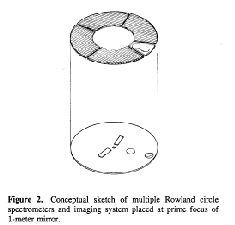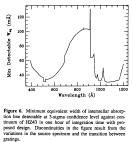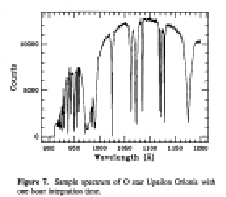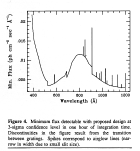|
|||||||||||||||||||
|
|
|||||||||||||||||||
|
|
A High Resolution Spectrometer for EUV/FUV Wavelengths
Mark Hurwitz and Stuart Bowyer
Space Sciences Laboratory University of California
Berkeley, California 94720
To combine the advantages
of the observing time available with a free-flying platform, the
reliability of the shuttle, and the large physical dimensions of Aries
sounding rocket payloads, the German Ministry of Sciences is
considering the development of an advanced Spartan platform. The
platform, like existing Spartans, will use the space shuttle as a boost
and recovery vehicle. Unlike existing Spartans it will be developed and
built in Germany and will be designed specifically to accommodate
Aries-class (I meter diameter) astronomical payloads on flights of a
few days duration. We show one firm's concept of this platform in
Figure 1.
A payload under consideration for flight with this carrier would carry out spectroscopy of astronomical sources in the 400 to 1200 Å band. The primary optic for this payload is being developed by the Astronon-dcal Institute of Tubingen and expected to be a 1-meter normal incidence f/2.7 primary mirror coated with iridium. Light collected by this optic will be directed by a movable pick-off mirror to one of two spectrometer systems. The prime spectrometer will be built by Berkeley and will cover the 400 - 1200 Å bandpass with a resolution of 3000 to 4000. A second spectrometer will be built by researchers at Heidelberg and will cover 900 - 1200 Å with a resolution of 10,000. In the sections that follow we provide a brief description of the scientific objectives of the mission and describe the Berkeley instrument in some detail. The performance of the instrument is discussed and simulated sample spectra are shown.
A substantial number of astrophysical topics can be investigated with an instrument of this type. Of substantial scientific interest will be studies of the interstellar medium. Nearly all phases of the ISM can be probed in this spectral range. Molecular hydrogen, found in the coldest interstellar clouds, has a large number of transitions between 912 and 1120,&. Measurement of the extinction and reddening of hot stars by cold interstellar clouds will allow a determination of the size and composition of interstellar dust grains in these clouds. Absorption lines of many species and absorption edges of neutral H and He will be seen against background sources such as hot white dwarfs. Studies of this type will answer fundamental questions about the cosmic abundance of elements in the ISM.
In the area of stellar physics, this instrument will allow determination of the temperature and luminosity of hot 0 stars by measuring absolute fluxes in the spectral region where most of their emission occurs. legh spectral resolu- tion profiles of lines formed in the extended atmospheres of these stars will provide information about their winds. The coronae of cool stars m also be studied. The temperatures of these coronae lie somewhere in the 104 to 107 K range. Ions formed under these conditions have many lines in the bandpass of this instrument. Acereting binary systems should also prove to be strong sources in the extreme ultraviolet. The instrument's ability to attach a wavelength and arrival time to each measured photon will allow the variation of the spectrum during the orbital period of the binary to be examined. This will bring about a better understanding of the accretion morphology of these systems.
We plan also to study quasars and active galactic nuclei. Important lines that can be observed with this instrument include the 0 VI doublet, which will yield information about the velocity structure and morphology of hot gas in the system. Observations of the C HI line at 977,X, when combined with existing IUE or future Space Telescope measurements of the C HI 1909A line, will give us a highly sensitive temperature probe. Study of bright AGNs might yield information about the intergalactic medium in the same way that the study of sources within our own galaxy will yield information about the interstellar medium.
 Our goal has been to design a spectrometer
with a resolution exceeding 2000 across the stated bandpass with the
maximum throughput possible. We have analyzed many designs, both
grazing and normal incidence, both with and without a secondary
telescope mirror (Cassegrain designs). The class of design that best
achieves our goal is a multiple Rowland circle spectrograph placed at
the prime focus of the paraboloidal primary mirror. Light entering the
telescope is brought to a focus by a 1-meter, f/2.7 paraboloidal
primary mirror. A circular aperture is placed at the prime focus to
reduce background contamination. The beam diverges from the prime focus
and strikes an array of four toroidal diffraction gratings (shown with
imaging tracking system in Figure 2). Each grating has a line density
appropriate to its spectral bandpass. Only two detectors are required;
a pair of spectra can be dispersed across each detector. Each detector
consists of two rnicrochannet plate stacks arranged so as to
pproximate the best focal surface (the Rowland circle) as closely as
possible. A far ultraviolet imaging system utilizing a small fraction
of the total beam will locate the target in the slit and provide
updated positions to allow us to correct for spacecraft drift (about I
" per second) post-flight.
Our goal has been to design a spectrometer
with a resolution exceeding 2000 across the stated bandpass with the
maximum throughput possible. We have analyzed many designs, both
grazing and normal incidence, both with and without a secondary
telescope mirror (Cassegrain designs). The class of design that best
achieves our goal is a multiple Rowland circle spectrograph placed at
the prime focus of the paraboloidal primary mirror. Light entering the
telescope is brought to a focus by a 1-meter, f/2.7 paraboloidal
primary mirror. A circular aperture is placed at the prime focus to
reduce background contamination. The beam diverges from the prime focus
and strikes an array of four toroidal diffraction gratings (shown with
imaging tracking system in Figure 2). Each grating has a line density
appropriate to its spectral bandpass. Only two detectors are required;
a pair of spectra can be dispersed across each detector. Each detector
consists of two rnicrochannet plate stacks arranged so as to
pproximate the best focal surface (the Rowland circle) as closely as
possible. A far ultraviolet imaging system utilizing a small fraction
of the total beam will locate the target in the slit and provide
updated positions to allow us to correct for spacecraft drift (about I
" per second) post-flight.
This design allows each grating to see a relatively slow beam, thus reducing grating aberrations. As compared to the use of a secondary mirror to slow the beam, our design is equal in throughput and results in higher resolution. Tle equality in efficiency is due to the relatively low reflectivity (about 20%) of iridium and other inert coatings at EUV wavelengths. Our design allocates about 20% of the area of the primary mirror to each grating, hence the rough equivalency in terms of throughput. If a secondary mirror were used to slow the beam, it would enlarge the image blur, drift, and jitter through the unavoidable magnification of the effective focal length. Our design does not suffer this effect. Furthermore, our design takes advantage of the annular nature of the beam (the inner .5 meter of the aperture is blocked by the spectrometer) and splits the f/2.7 beam into four sections each slower than f/5.4.
The resolution of the system will be determined by how precisely we can remove the spacecraft pointing drift from the spectra in the data analysis. The image size of the primary mirror is expected to have a half energy width less tnan one arcsecond and will not limit the resolution. We have chosen to optimize a design based on an uncorrected drift of 4" which will require an update from the imaging system every 4 seconds. This value of the uncorrected drift was chosen based on detector limitations. When multiplied by the focal length 4' corresponds to a spot size of 52 microns on the detectors. To calculate the spectral resolution this value is summed in quadrature with the grating aberrations to produce a total optics/drift blur of about 60 microns. A detector pixel size of 30 microns is required to sample this blur fully. This represents a challenging but achievable goal for the quasi 1-dimensional detectors 30 mm long (each MCP stack) we plan to use. To sample an optics/drift blur much smaller than 60 microns would present formidable problems in detector design; hence we do not consider drift update periods less than 4 seconds. We optimized the parameters of the design (line densities, blaze angles, etc.) given the 4" uncorrected drift discussed above subject to the constraints imposed by the dimensions of the platform and the limits imposed by diffraction grating manufacturing techniques. The parameters of the finalized design are summarized in Table 1.
| Table 1 | |
|---|---|
| Diameter of Rowland Circle | 1300 mm |
| Second Radius of Curvature of Toroid | 1282 mm |
| Incidence Angle | 9.5 degrees |
| Blaze Angle | 4.7 degrees |
| Line Densities and Wavelength Coverage | |
| 3658 lines/mm | 389- 523 Å |
| 2774 lines/mm | 512 - 690 Å |
| 2104 lines/mm | 676 - 910 Å |
| 1595 lines/mm | 910 - 1200 Å |
 The spectral resolution of the design
increases with wavelength from 3000 to 4000 within each sub-bandpass.
This variation with wavelength is due to the fact that the resolution
is primarily opticsidrift blur limited. The resolution element
measured in Angstroms is roughly constant across each sub-bandpass,
resulting in a resolution which increases with wavelength. We have
performed geometrical raytraces of the design and verified that it
delivers the stated spectral resolution. Off-axis aberrations are
negligible given the absolute pointing accuracy ± 10"
expected for the
platform. To calculate the effective area of the instrument we
include the reflectance of the iridium-coated primary and grating, the
quantum efficiency of the detector, and a diffraction efficiency 50% of
the value theoretically attainable (nearly 100% at all wavelengths). We
show the effective area in Figure 3.
The spectral resolution of the design
increases with wavelength from 3000 to 4000 within each sub-bandpass.
This variation with wavelength is due to the fact that the resolution
is primarily opticsidrift blur limited. The resolution element
measured in Angstroms is roughly constant across each sub-bandpass,
resulting in a resolution which increases with wavelength. We have
performed geometrical raytraces of the design and verified that it
delivers the stated spectral resolution. Off-axis aberrations are
negligible given the absolute pointing accuracy ± 10"
expected for the
platform. To calculate the effective area of the instrument we
include the reflectance of the iridium-coated primary and grating, the
quantum efficiency of the detector, and a diffraction efficiency 50% of
the value theoretically attainable (nearly 100% at all wavelengths). We
show the effective area in Figure 3.
The minimum detectable flux in
each spectral pixel depends not only on the effective area but on the
background rate as well. Diffuse airglow lines will contribute to the
background in wavelength intervals determined by the width of the
entrance slit, and scattered Lyman alpha radiation and detector dark
counts will contribute to an overall background rate. We assume a full
slit width of 30" for our calculations. Scatterin@f of 3.25 Uorayleighs
of Lyman alpha at a level of 10 /,& is included, as well as a detector
dark count rate of I count/cm2/sec. We show the 3-sigma minimum flux
detectable in I hour of observation in Figure 4.
 In Figure 5 we show a sample spectrum of the hot white dwarf HZ 43
assuming an integration time of 1 hour. Our model is that of Basri
(personal communication) viewed through a column density of hydrogen
and helium determined by Auer and Shipman1. Poissonian
noise due to subtraction of the background discussed above has been
added. Major interstellar absorption lines of H and He are shown. Other
lines are detectable as well;
In Figure 5 we show a sample spectrum of the hot white dwarf HZ 43
assuming an integration time of 1 hour. Our model is that of Basri
(personal communication) viewed through a column density of hydrogen
and helium determined by Auer and Shipman1. Poissonian
noise due to subtraction of the background discussed above has been
added. Major interstellar absorption lines of H and He are shown. Other
lines are detectable as well;
 in Figure 6 we show the minimum
equivalent width of an absorption line detectable in 1 hour at the
3-sigma level against the background continuum of HZ 43. Many lines
of several species are expected to lie above this level.
in Figure 6 we show the minimum
equivalent width of an absorption line detectable in 1 hour at the
3-sigma level against the background continuum of HZ 43. Many lines
of several species are expected to lie above this level.
 In Figure 7 we show the far ultraviolet spectrum of a main sequence
O9 star2
511 pc distant located behind 5.6 magnitudes of UV extinction assuming
1 hour observing time. The need for brevity, not a dearth of
interesting targets limits the number of sample spectra included in
this summary.
In Figure 7 we show the far ultraviolet spectrum of a main sequence
O9 star2
511 pc distant located behind 5.6 magnitudes of UV extinction assuming
1 hour observing time. The need for brevity, not a dearth of
interesting targets limits the number of sample spectra included in
this summary.
We have designed an efficient spectrometer for high- resolution studies of point sources in the 400 - 1200 Å bandpass. This spectrometer fits within the envelope available in the advanced Spartan platform under consideration for development by West Germany. The maiden flight of this instrument will provide a wealth of data in this unexplored region of the spectrum.
This work was supported by NASA grant NGR-05- 003-450 and NSF grant INT-8116729.
1. Auer, L.H. and Shipman, H.L., Ap. J. Letters, 211, L103, 1977.
2. Bradley and Morton, Ap. J., 156, 687, 1969.
This paper is was originally published as Hurwitz, M., & Bowyer, S."A High Resolution Spectrometer for EUV/FUV Wavelengths",Instrumentation in Astronomy VI, David L. Crawford, Editory, Proc. SPIE, 627, 375-378 (1986). Provided here with permission of the authors.
|
|
|




 Follow Us
Follow Us

